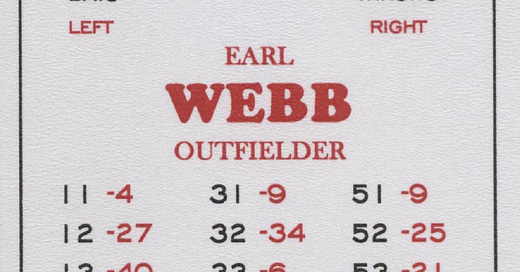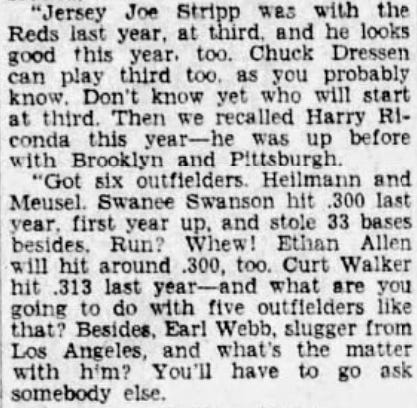Earl Webb's 1930 Adventure
If you’re like me, you start poking around with things and asking questions.
I guess it’s a restless habit. Maybe it comes with having too much time on my hands. Or maybe I’m just too curious for my own good.
You see — when I was rummaging through my beloved National Pastime cards the other day, I came across this fellow:
There’s nothing special about him, right? Looks like an average National Pastime card — nothing that particularly stands out to me. APBA players would consider the “39” on dice role 35 to be something obscene, and the “37” on 42 to be something vulgar. He’s also got a “40” on dice roll 13, which means you’d better get used to rerolling when this guy’s up with the bases empty.
But none of that is all that unique or special.
No — the interesting thing about Webb is that his card is with the Boston Red Sox.
I noticed this because I found this interesting announcement about Webb from the opening day Washington D.C. newspapers:
We should have him play with the Nationals at the start of the season, right?
Well, no. It turns out that Webb didn’t actually play a game for Washington.
So let’s dig in and see what happened.
Earl Webb is one of those interesting players that you never forget once you run into them.
Webb played well as a 28 year old rookie for the Chicago Cubs back in 1927, hitting .301 in 395 plate appearances, including 14 home runs. He stayed on with the club in 1928, but his stats faded a bit. He found himself on the Pacific Coast before too long.
One thing’s for sure: Webb was a star in Los Angeles. It wasn’t all that unusual to see him hit two home runs in an offensive power show like this one:
In 188 games in 1929 (remember, the PCL had an expanded schedule in those days), Webb hit .357, slugged .629, and walloped 37 home runs. Long story short: he was ready for the major leagues.
Naturally, that meant he was drafted by a major league team.
It looked like the Reds had an embarrassment of riches in the outfield for 1930:
But, as we saw earlier, Webb wound up with Washington on April 14.
I’m not entirely sure I understand why. Webb played in a few spring training games after arriving somewhat late. Near the end of spring training he was playing on the secondary team with the rookies. It’s possible taht they felt there simply wasn’t room for him in the outfield.
Webb apparently looked impressive at first in Washington:
There was a question as to precisely how Webb would fit into the lineup, however. With an outfield consisting of Goose Goslin, Sam West, and Sam Rice, Webb was kind of the odd one out, destined to stay on the bench:
And then came the waiting game.
Rumor had it that Webb would finally start for Washington on a long home stretch the club had:
In fact, The Washington Times seemed absolutely sure of it:
But, only a few days later, Webb was traded again:
It kind of makes you wonder why in the world Washington picked up Webb in the first place. Apparently they didn’t realize he was left handed.
Anyway — Webb is one of the few players who appeared on two different major league rosters before he appeared in a single game in a season.
The 1930 Red Sox were awful. Webb made the most of his chances, though, hitting .323 with 16 home runs and 66 runs batted in. He wound up hitting .306 in his 7 season Major League career — not bad for a guy who didn’t really get a chance in the big leagues until he was 28.
30 year old outfielder Bill Barrett, meanwhile, appeared in only 6 games for Washington, almost all of which were pinch hitting roles. Washington sold him to the Minneapolis Millers of the American Association on June 4th, who then sold him along to Kansas City. He never played in the major leagues again.
Maybe the Nationals should have kept Webb after all.
















Interesting: I'd read that Cincinnati had become the Redlegs (one word) after WWII when Reds became synonymous with "Communists" in general conversation. (NY Times sportswriter Art Daley quoted someone -- can't remember who -- complaining that Cincy had been the Reds before the Commies were, and it was the Russians who ought to change.) So seeing it here in 1930 (twice, so it wasn't just an sportswriter's alternate usage, like Bengals for Detroit or Mackmen for the A's) surprised me a bit. Another thing was the report that rosters didn't reduce to 25 players until June 15, and that Washington was carrying 27. Certainly news to me. (I was a little surprised you didn't mention Earl Webb's all-time record 67 doubles in 1931, since it's just about the only thing he's remembered for.)